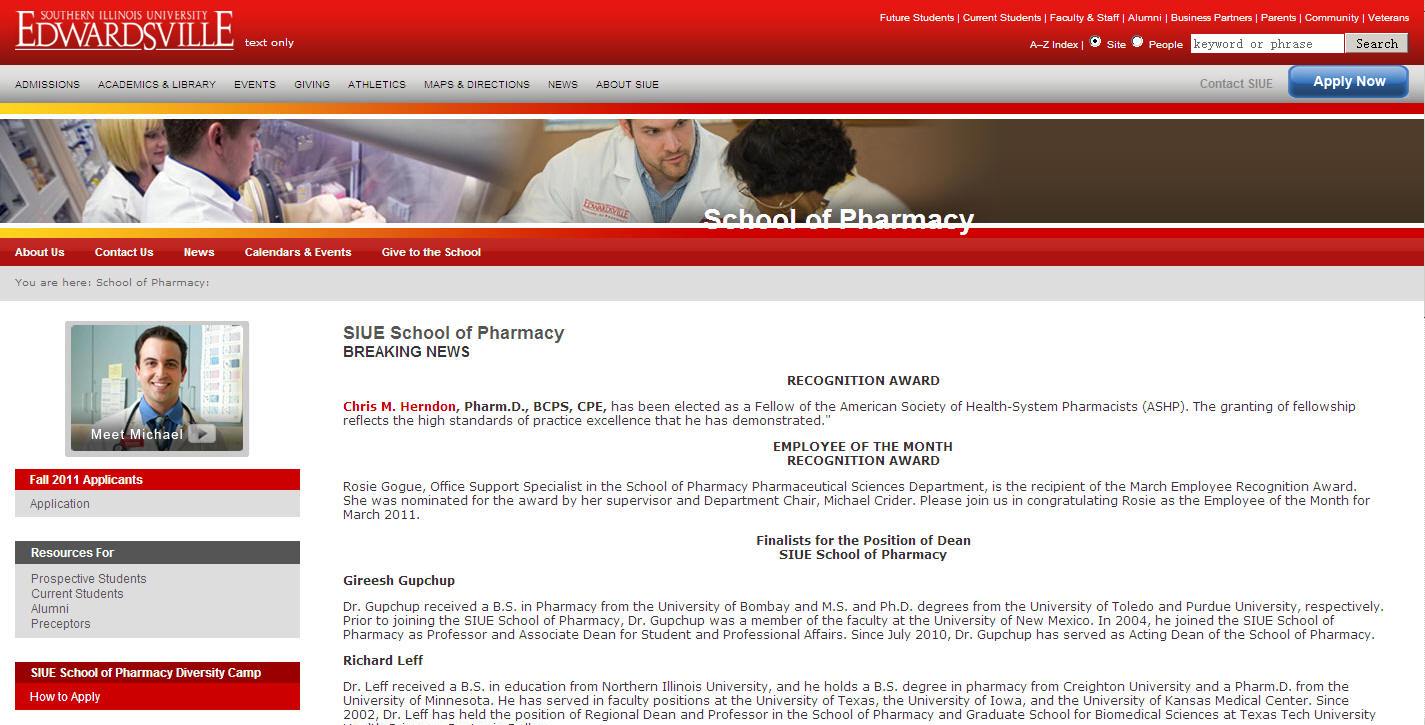The Illinois pharmacy schools were built for those who own a bachelor degree and want to pursue a four-year advanced degree of Doctor of Pharmacy (or PharmD) in Illinois. Please note that PCAT which stands for Pharmacy College Admissions Test is required for applicants for admissions to pharmacy schools, while Doctor of Pharmacy is a must for those who want to consider working as a pharmacist in Illinois.
This page lists all Illinois pharmacy colleges that are accredited by the ACPE – Accreditation Council for Pharmacy Education. Included are complete contact information and website addresses of all Pharmacy schools, colleges, and universities within the state of Illinois.
| Rank | Pharmacy University | ||
| 1 | University of Illinois-Chicago College of Pharmacy Address: 833 S. Wood Street, Chicago, IL 60612 Phone: (312) 996-7242 E-mail: uicpharm@uic.edu Website: http://www.uic.edu/pharmacy/ |
||
 |
|||
| 2 | Midwestern University College of Pharmacy Address: 555 31st Street, Downers Grove, IL 60515 Phone: (630) 515-6171 E-mail: admissil@midwestern.edu Website: http://www.midwestern.edu/Programs_and_Admission/IL_Pharmacy.html |
||
 |
|||
| 3 | Southern Illinois University-Edwardsville School of Pharmacy Address: Campus Box 2000, Edwardsville, IL 62026 Phone: (618) 650-5150 E-mail: pharmacy@siue.edu Website: http://www.siue.edu/pharmacy/ |
||

Illinois
Illinois is a state in the Midwest of the United States, leading in the Northeast Center group. The area is 150 thousand km². Population – 12.4 million people (2000) (the fifth largest state in terms of the number of inhabitants). The capital is Springfield, the largest city is Chicago; other major cities: Rockford, Peoria, Aurora, Naperville, Decatur.
State nicknames:
Land of Lincoln
Prairie State
Geography and climate
The state is located on the Central Plains, and 60% of its territory is occupied by prairies, the rest is occupied by hills. It borders Wisconsin to the north, Lake Michigan to the northeast, Indiana to the east and southeast, Kentucky to the south, and Iowa to the west. The southern border runs along the river. Ohio, western and southwestern – along the river. Mississippi.
There are more than 500 rivers in the state (the largest is Illinois) and 950 lakes.
Moderate continental climate.
The state is rich in minerals, including coal, oil, natural gas, zinc, and sandstone.
History
The first man appeared here ca. 5000 BC e., in the XVII – early XIX centuries. the Illiniwec Indians, the ancestors of the Illinois, lived here.
The lands of the future state were first surveyed in 1673 by two Frenchmen – the Jesuit missionary Jacques Marquette and the explorer Louis Jollier, in 1680. Illinois was surveyed by Robert Lasalle.
The French dominated here until 1763, but, like the British, they did not leave a noticeable mark on the history of the region. In 1778, during the War of Independence, the British were expelled from these places by militia under the command of J. R. Clark, and the territory became part of Virginia. In 1787, Illinois was divided into counties and given official status by the Ordinance of the Northwest, and in 1809 the Territory of Illinois was created and mass settlement began. In 1818, Illinois received statehood (21st in a row). It was one of five states that formed out of the Northwest Territory. The first constitution was adopted in 1818, followed in 1848, 1870 and 1970. In the 30s. 19th century construction of canals and railways began. In 1832, bloody clashes took place between the settlers and the Indians, which went down in history as the Black Hawk War. In 1844, the Mormons were expelled from the state. Since 1850, Illinois has occupied a leading position in all sectors of the country’s economy. During the Civil War, the state supported its native President Lincoln, sent 250,000 men to the Union Army, and became a major supplier of grain and meat to northerners. In 1871, the state survived the devastating Chicago fire.
By 1880, Illinois was the fourth largest city in terms of population and received several waves of European immigration. In the late 19th and early 20th centuries, the state became the scene of a powerful development of the trade union and labor movement, the strike movement and serious class conflicts. As a result, by the end of the century, the working people achieved the reform of industrial inspection and the recognition of trade unions; by 1903, the introduction of an 8-hour working day and the limitation of the working week of adolescents to 48 hours; and in 1909, a 10-hour working day was introduced for women. The economic and social growth of the state continued during both world wars.
The post-war period saw the modernization of industry and agriculture, the rapid growth of the population. At present, the process of formation of large farms continues, the change in the ethnic composition of large cities at the expense of minorities, the position of the state as one of the most important trade and financial centers of the country is being strengthened.
Economy
Industry with the main center in the Chicago area since the beginning of the 20th century allows the state to occupy one of the first places in industrial development in the country; among the leading industries today are oil refining, mechanical engineering, the food industry, the production of electrical equipment, and the chemical industry.
Historically, the most important role was played by the manufacturing industry – meat processing, woodworking, food.
Large farms are developed (corn, soybeans, wheat, cattle breeding, pig breeding); from the end of the 19th century the state is the initiator of many innovations in agriculture.
Fishing is developed in inland waters (carp, catfish, etc.).
A significant place in the economy is occupied by tourism and the service sector.
Illinois is the country’s leading multi-industry transportation center.
Politics
The state has always had a great influence on the political life of the United States in general. If in the 19th century Republican influence prevailed here, then in the 20th century. Both political parties play an important role in politics.
